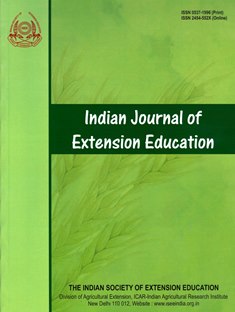Food, Economic, and Livelihood Security of Farmers under PMFBY in Kolar, Karnataka
DOI:
https://doi.org/10.48165/IJEE.2025.61208Keywords:
Livelihood security, Food security, Economic security, PMFBY, Agricultural Insurance, Crop insurance and farmers welfareAbstract
Indian agriculture faces multiple risks that threaten farmers livelihoods. The Pradhan Mantri Fasal Bima Yojana (PMFBY) was introduced to mitigate these risks through crop insurance. This study evaluates the impact of PMFBY on the food and economic security of farmers in Kolar district, Karnataka, during 2021–2022. A total of 200 farmers (150 beneficiaries, 50 non-beneficiaries) were surveyed across five taluks. Food and economic security were assessed using specific indicators. Findings indicate that PMFBY beneficiaries experienced slightly better livelihood security than non-beneficiaries. Beneficiaries prioritized year-round food access (mean: 4.63), while non-beneficiaries relied more on the adequacy of Public Distribution System (PDS) grains (mean: 4.48). Economic security was primarily associated with optimal resource utilization (beneficiaries: 4.61; non-beneficiaries: 4.52). Overall, 53.5 per cent of beneficiaries reported improved food security and 57 per cent experienced enhanced economic stability. The results suggest a modest positive impact of PMFBY on farmer resilience. However, challenges such as delayed insurance payouts and awareness gaps persist. Strengthening implementation, improving claim processing, and increasing outreach efforts could enhance the scheme’s effectiveness. Continuous evaluation is essential to optimize PMFBY’s role in promoting sustainable agricultural livelihoodsDownloads
References
Agarwal, S. K., Gupta, S., Singh, V., Sutar, R. F., & Nair, D. (2022). Insurance as an instrument of financial security in addressing mental illness among agricultural workers in the LMICs. medRxiv. https://doi.org/10.1101/2022.02.21.22271272
Birthal, P. S., & Hazrana, J. (2019). Crop diversification and resilience of agriculture to climatic shocks: Evidence from India. Agricultural Systems, 173, 345–354. https://doi.org/10.1016/ j.agsy.2019.02.008
Dev, S. M., & Mahajan, V. (2020). Agricultural risk and insurance in India: An overview. Indian Journal of Agricultural Economics, 75(3), 12–21.
Desai, S., Singh, P., & Patel, A. (2022). Understanding the impact of PMFBY on Indian farmers. Agricultural Economics Research Review, 35(2), 234–256.
Diao, X., & Pratt, A. N. (2007). Growth options and poverty reduction in Ethiopia—An economy-wide model analysis. Food Policy, 32(2), 205–228. https://doi.org/10.1016/j.foodpol.2006.02.004
Ghosh, R. K., Gupta, S., Singh, V., & Ward, P. S. (2021). Demand for crop insurance in developing countries: New evidence from India. Journal of Agricultural Economics, 72(1), 293–320. https:// doi.org/10.1111/1477-9552.12401
Jabbar, A., Wu, Q., Peng, J., Sher, A., Imran, A., & Wang, K. (2020). Mitigating catastrophic risks and food security threats: Effects of land ownership in Southern Punjab, Pakistan. International Journal of Environmental Research and Public Health, 17(24), 9258. https://doi.org/10.3390/ijerph17249258
Kumar, A., & Swami, P. S. (2021). Climate change in South Asia: Impact, adaptation and role of GI science. In S. K. Singh, S. Kanga, W. Meraj, F. Farooq, & Sudhanshu (Eds.), Geographic information science for land resource management (pp. 1-18). John Wiley & Sons Inc. and Scrivener Publishing, LLC.
Kumar, A., Singh, R., & Sharma, P. (2023). Farmers’ awareness and perception of crop insurance schemes: A study in Northern India. Indian Journal of Extension Education, 59(2), 112-118.
Kumar, R., Mishra, A., & Gupta, N. (2020). Modern agricultural practices and risk mitigation: The role of crop insurance. Journal of Development Studies, 56(8), 1021–1035. https://doi.org/ 10.1080/00220388.2019.1685316
Meena, R. K., Sharma, H., & Rathore, S. (2021). Challenges in PMFBY implementation. Journal of Rural Studies, 84, 35–48. https://doi.org/10.1016/j.jrurstud.2021.03.011
Mehrabi, Z., Delzeit, R., Ignaciuk, A., Levers, C., Braich, G., Bajaj, K., & You, L. (2022). Research priorities for global food security under extreme events. One Earth, 5(7), 756–766. https://doi.org/ 10.1016/j.oneear.2022.05.012
Ministry of Agriculture & Farmers Welfare. (2020). Annual Report 2019–20. Government of India.
Nain, M. S., Singh, R., & Mishra, J. R. (2017). A study of farmers’ awareness on Agricultural Insurance Schemes in Southern Haryana. Indian Journal of Extension Education, 53(4), 75-79.
Patel, D. D., & Mehta, P. (2021). Challenges in the implementation of Pradhan Mantri Fasal Bima Yojana: Insights from Gujarat. Indian Journal of Extension Education, 57(3), 85-90.
Rose, D., & Charlton, K. E. (2001). Prevalence of household food security in South Africa: Results from a large, nationally representative survey. Public Health Nutrition, 5(3), 383–389. https://doi.org/10.1079/PHN2001281
Saxena, S. P., & Kumar, A. (2019). Economic analysis of climate change impact, adaptation, and mitigation on potato farming in India with special reference to Agra District. Indian Journal of Economics and Development, 7(3), 1–7.
Sharma, P. (2021). Policy analysis of PMFBY: Achievements and challenges. International Journal of Agricultural Policy and Research, 9(1), 78–89.
Shwetha, N. V., Sachan, S., & Shivalingaiah, Y. N. (2021). Comparative analysis of livelihood security of the farmers practicing different farming systems in Mandya district of Karnataka. Plant Archives, 21(1), 457–462.
Shwetha, S., Reddy, B. S., & Reddy, M. J. (2022). Impact of Pradhan Mantri Fasal Bima Yojana on farmers’ livelihood security in Karnataka. Indian Journal of Extension Education, 58(1), 45- 49.
Tiwari, R., Chand, K., & Anjum, B. (2020). Crop insurance in India: A review of Pradhan Mantri Fasal Bima Yojana (PMFBY). FIIB Business Review, 9(3), 249–255. https://doi.org/10.1177/ 2319714520935930
Todmal, R. S. (2022). Link between monsoon rainfall variability and agricultural drought in the semi-arid region of Maharashtra, India. Current Science, 122(8), 934.
Downloads
Published
Issue
Section
License

This work is licensed under a Creative Commons Attribution-NonCommercial-NoDerivatives 4.0 International License.

